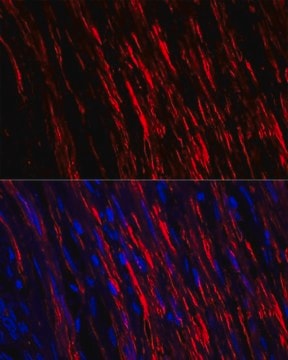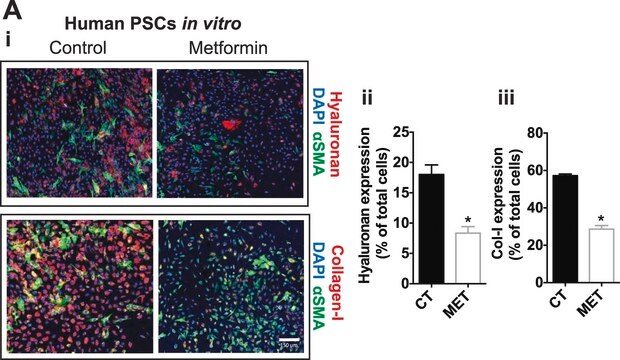MABT823
Anti-alpha-Actin Antibody, Cardiac Muscle Antibody, clone 22D3
clone 22D3, from mouse
Synonyme(s) :
Actin, alpha cardiac muscle 1, Alpha-cardiac actin
About This Item
Produits recommandés
Source biologique
mouse
Niveau de qualité
Forme d'anticorps
purified immunoglobulin
Type de produit anticorps
primary antibodies
Clone
22D3, monoclonal
Espèces réactives
rat, human, goat, rabbit
Réactivité de l'espèce (prédite par homologie)
porcine (based on 100% sequence homology), mouse (based on 100% sequence homology)
Technique(s)
flow cytometry: suitable
immunocytochemistry: suitable
immunofluorescence: suitable
western blot: suitable
Isotype
IgG1κ
Numéro d'accès NCBI
Numéro d'accès UniProt
Conditions d'expédition
ambient
Modification post-traductionnelle de la cible
unmodified
Informations sur le gène
human ... ACTC1(70)
Description générale
Spécificité
Immunogène
Application
Immunofluorescence Analysis: A representative lot immunostained cardiomyocytes in human left ventricular endocardial biopsies, rabbit left ventricular myocardium, as well as in goat atrial myocardium frozen tissue sections by fluorescent immunohistochemistry (Driesen, R.B., et al. (2009). J. Cell. Mol. Med. 13(5):896-908).
Western Blotting Analysis: A representative lot specifically detected alpha-cardiac actin in rat myocardium homogenate with no cross-reactivity toward - or -smooth muscle actin in rat aorta and chicken gizzard homogenates, cytoplasmic - or -actin in human platelet lysate, nor -skeletal actin in rat skeletal muscle homogenate (Driesen, R.B., et al. (2009). J. Cell. Mol. Med. 13(5):896-908).
Cell Structure
Qualité
Flow Cytometry Analysis: 2 µL of this antibody detected alpha-cardiac actin in one million 4% paraformaldehyde-fixed, 0.2% Triton X-100-permeabilzed HeLa cells.
Description de la cible
Forme physique
Stockage et stabilité
Autres remarques
Clause de non-responsabilité
Vous ne trouvez pas le bon produit ?
Essayez notre Outil de sélection de produits.
Code de la classe de stockage
12 - Non Combustible Liquids
Classe de danger pour l'eau (WGK)
WGK 1
Point d'éclair (°F)
Not applicable
Point d'éclair (°C)
Not applicable
Certificats d'analyse (COA)
Recherchez un Certificats d'analyse (COA) en saisissant le numéro de lot du produit. Les numéros de lot figurent sur l'étiquette du produit après les mots "Lot" ou "Batch".
Déjà en possession de ce produit ?
Retrouvez la documentation relative aux produits que vous avez récemment achetés dans la Bibliothèque de documents.
Notre équipe de scientifiques dispose d'une expérience dans tous les secteurs de la recherche, notamment en sciences de la vie, science des matériaux, synthèse chimique, chromatographie, analyse et dans de nombreux autres domaines..
Contacter notre Service technique








